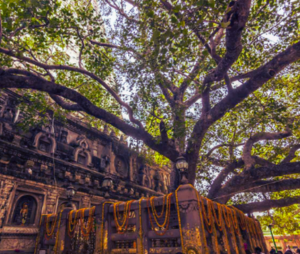Mahabodhi : Where Faith and Heritage Converge in Divine way
Introduction
Mahabodhi Temple
The Temple is extremely important since it is the location where Lord Buddha gained enlightenment more than 2,500 years ago. This holy location, which is decorated with an impressive architectural fusion of several eras, is a popular pilgrimage spot for Buddhists all over the world. The temple complex is home to the well-known Bodhi Tree, which represents enlightenment, as well as a number of shrines that represent the historical and spiritual roots of Buddhism.

What is the Temple of Mahabodhi?
In Bodh Gaya, India, there is a Buddhist temple called the Mahabodhi Temple situated on an 11.9-acre compound. It consists of the Lotus Pond, the Animesh Lochana Chaitya, the Temple, and the Bodhi Tree—under which the Buddha meditated and obtained enlightenment. Since it is the birthplace of Buddhism, it holds great significance in both the history of India and the religion of the area. The most significant place of pilgrimage for Buddhists is the Temple complex, which is also a UNESCO World Heritage Site.
The Temple's Architecture
The Mahabodhi Temple is next to the Phalgu River and situated in the state capital of Bihar. With four lesser, identical towers located at each corner of the main tower, the temple’s towering height is one hundred eighty feet. The four smaller temples are surrounded by a thirty-six-foot-tall temple wall. The main features of the towers include Buddha statues in niches, curved and arched decorative patterns, and ornamental carvings that portray scenes from the life of the Buddha. Because the towers are hollow, shrines and meditation spaces can be found inside the buildings.

Significant events and figures in the Mahabodhi Temple's history
- After being enlightened beneath the Bodhi Tree in 400 BC, Buddha founded Buddhism.
- 250 BC: Emperor Ashoka builds the Temple.
- 5th–6th century AD: Current Temple built.
- 1050 & 1295 AD: Buddhists from Burma help rebuild the dilapidated Mahabodhi Temple Complex.
- 13th century AD: Turkish empire repeatedly invades India.
- 13th–18th century AD: The Temple Complex was essentially abandoned.
- 1885 AD: Sir Edwin Arnold asks the British to return control of the temple to the Buddhists.
- 1891: The government of Ceylon forms the Mahabodhi’s Society and joins Sir Edwin Arnold in advocating for the temple’s restitution to Buddhists.
- 1949: The Bodh Gaya Act gives the Bihar government jurisdiction of the Temple Complex.
- 2002: Declared UNESCO World Site.
Bodhi Tree
Through meditation, Siddhartha Gautama attempted to achieve enlightenment in 400 BC. He undertook meditation under a fig tree in the village of Bodh Gaya. This is where he attained enlightenment and transformed into the Buddha, founding the new Buddhist faith. Because enlightenment is referred to in Sanskrit as bodhi, the fig tree under which Buddha meditated came to be known as the Bodhi Tree.







Pingback: See Innovative Indian’s Temples and a Journey Of Artistry